
FS-2023-0672 | September 2023
UNIVERSITY OF MARYLAND EXTENSION AND MARYLAND SEA GRANT COLLEGE
Maryland Shellfish Aquaculture Industry: 2021 at a Glance
Report Highlights
After facing a number of challenges in 2018-2020, the shellfish aquaculture industry in Maryland rebounded in 2021 with a record harvest for oyster aquaculture and the first reported farm-raised bay scallop harvest. The number of leases and acres leased for shellfish aquaculture remained largely consistent with 2020, but oyster harvest increased to a record high of over ninety thousand bushels and a dockside value of over $6 million (Maryland Department of Natural Resources, 2022).
2021: A Strong Year for Oyster Aquaculture
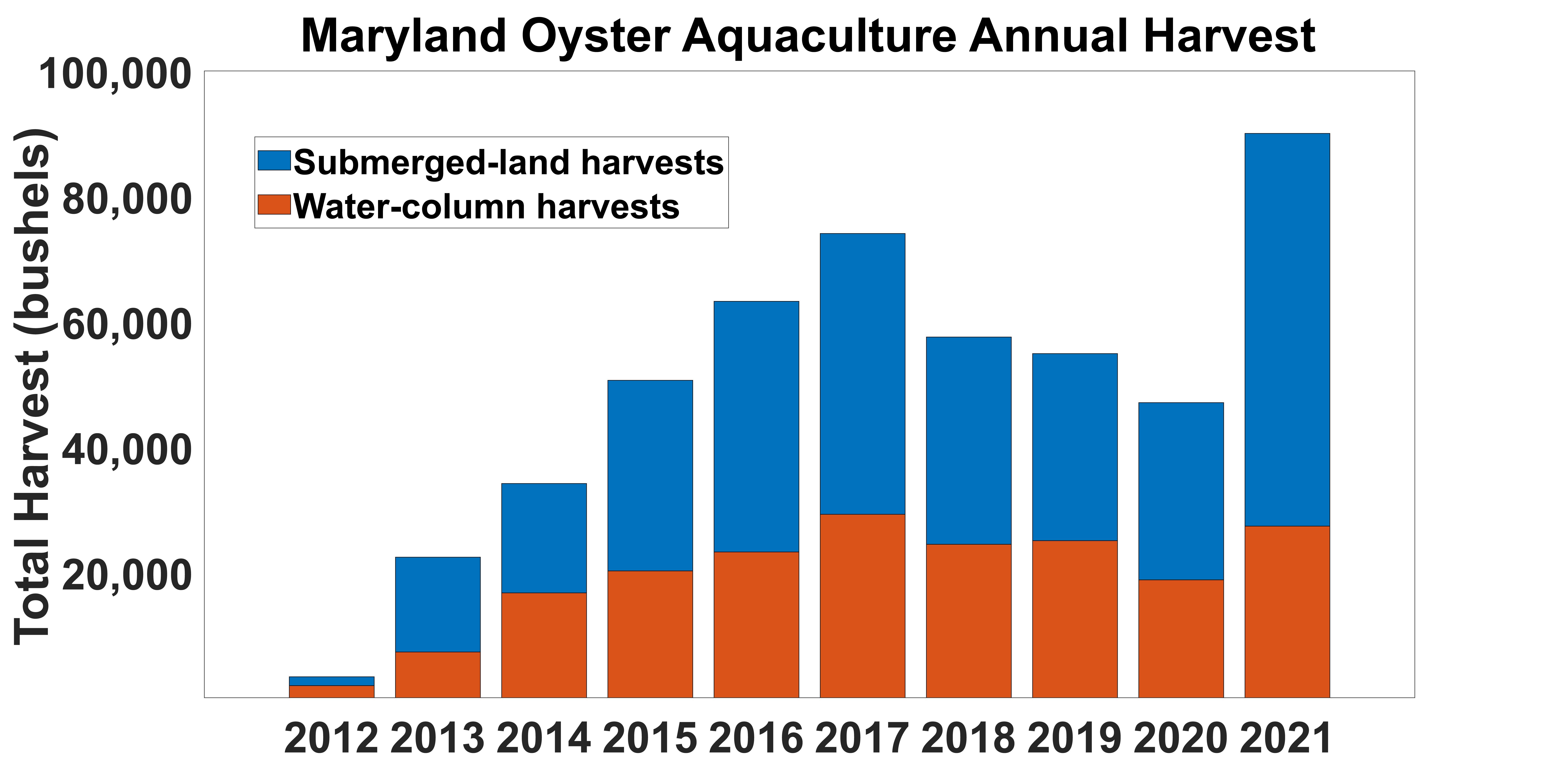

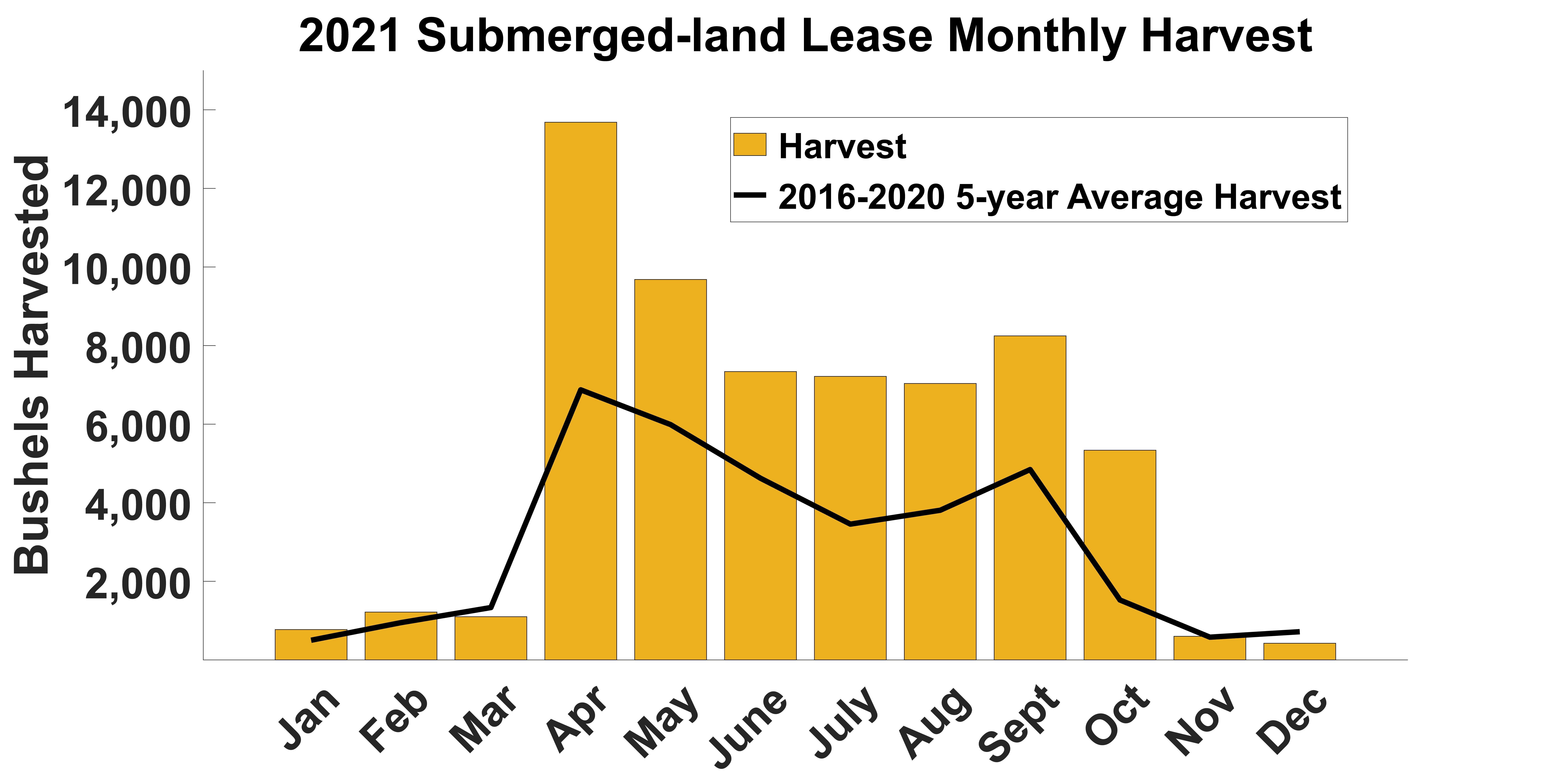
The 2021 oyster aquaculture harvest was the largest in Maryland since the restructured lease program took effect in 2010. The 2021 harvest registered 90,029 bushels of oysters (Crassostrea virginica), with 62,656 bushels harvested from submerged-land leases and 27,373 bushels from water-column types (Figure 1). Oysters grown on submerged-land leases are grown on and harvested directly from suitable bottom, while oysters grown on water-column leases are containerized (baskets, cages, bags) within the water-column, most commonly in cages that rest on the bottom or in surface floats. The 2021 harvest represented a 90% increase compared to 2020, with its harvest of 47,081 bushels, and represented a 50% increase compared to the previous five-year average of 59,366 bushels (2016-2020). The portion of 2021 harvest reported from submerged land leases was the largest since the new program took effect, while 2021 water-column harvest was second only to the 2017 harvest (Figure 1). Harvest from submerged-land leases typically occurs between April and October to avoid competition from the wild oyster fishery harvest, while water-column harvest is relatively consistent throughout the year (Figures 2 & 3).
The industry was buoyed in part by a partnership with The Nature Conservancy. The non-profit organization purchased approximately 4,200 bushels of large oysters (both water-column and submerged-land grown) from Maryland growers in 2021 through their Supporting Oyster Aquaculture and Restoration (SOAR) program, which are included in the harvest totals.
Oysters purchased through the SOAR program were planted on local sanctuary reefs. These purchases allowed oyster growers to offload oysters from their leases and to generate income during a time when markets were diminished due to the COVID-19 pandemic. Additionally, this helped alleviate space limitations for those growers who used containerized gear.
Economic Impact of Oyster Aquaculture in Maryland
The increased harvest from oyster leases in 2021 contributed to a record dockside value for farmed oysters since the new leasing program took effect. In 2021, the estimated dockside value of aquacultured oysters in Maryland was $6,236,347. This is an increase of over $2.5 million compared to the 2020 dockside value. The 2021 dockside value was also over $1 million higher than the previous high in 2017 (Figure 4).
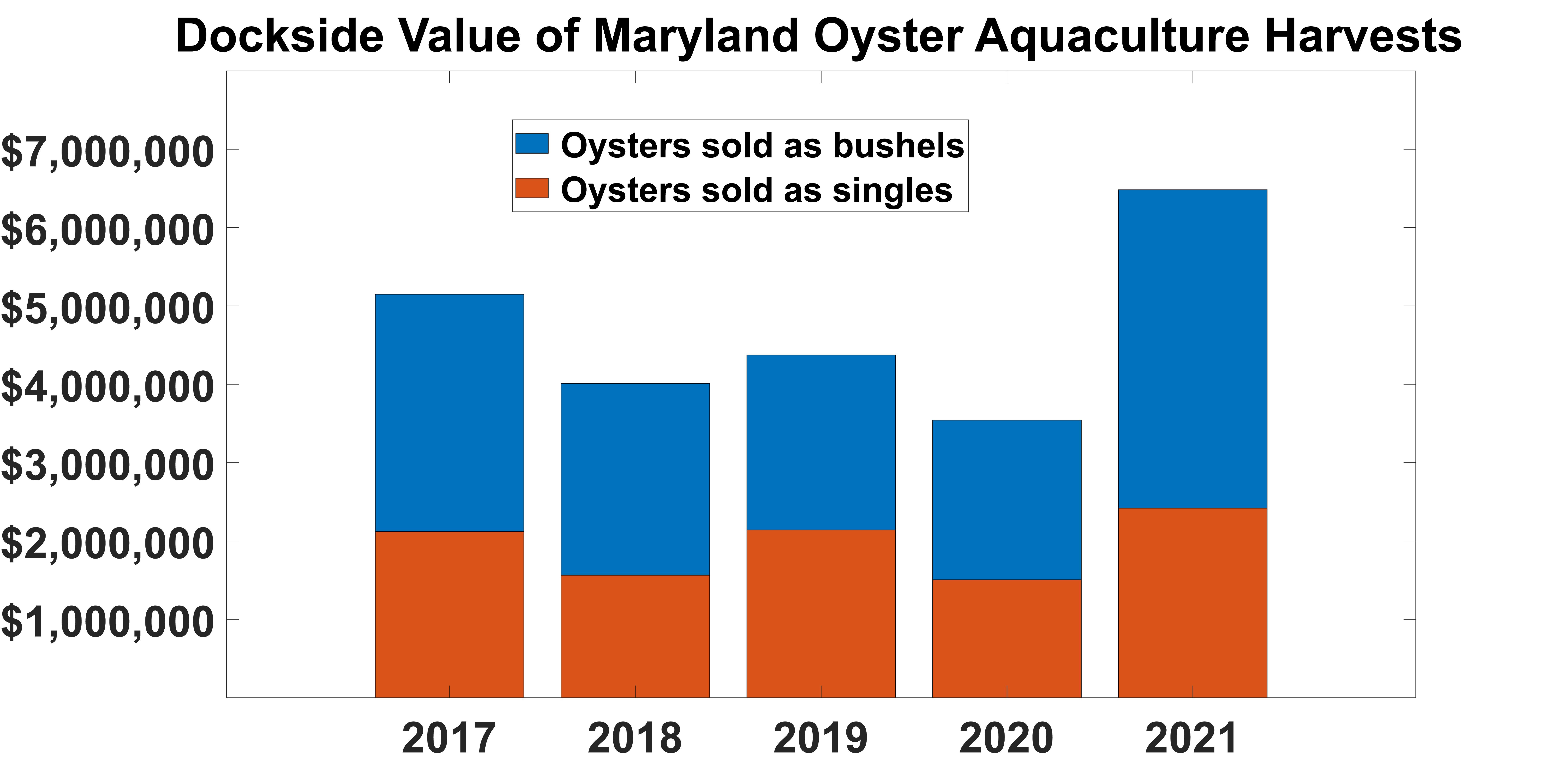
Oysters are sold by the bushel or individually as single oysters (“singles”). The average price for Maryland oysters sold by the bushel has remained steady at $55 per bushel since 2017. The average price per Maryland oyster sold as singles was $0.40 per oyster in 2017 and 2018, then increased to $0.50 per oyster in 2019 where it remained through 2021 (Maryland Department of Natural Resources, 2022). As with previous years, the total value of oysters sold to the bushel market in Maryland in 2021 was higher than the total value of oysters sold as singles (Figure 4). The Chesapeake Bay Foundation published a study in 2020 that determined the impact of the shellfish aquaculture industry on Maryland’s economy (van Senten et al., 2020). The authors of this publication used the economic ratios published in van Senten (2020) to estimate the total economic impact of the oyster aquaculture industry to the state of Maryland to be approximately $12 million in 2021.
Lease Data
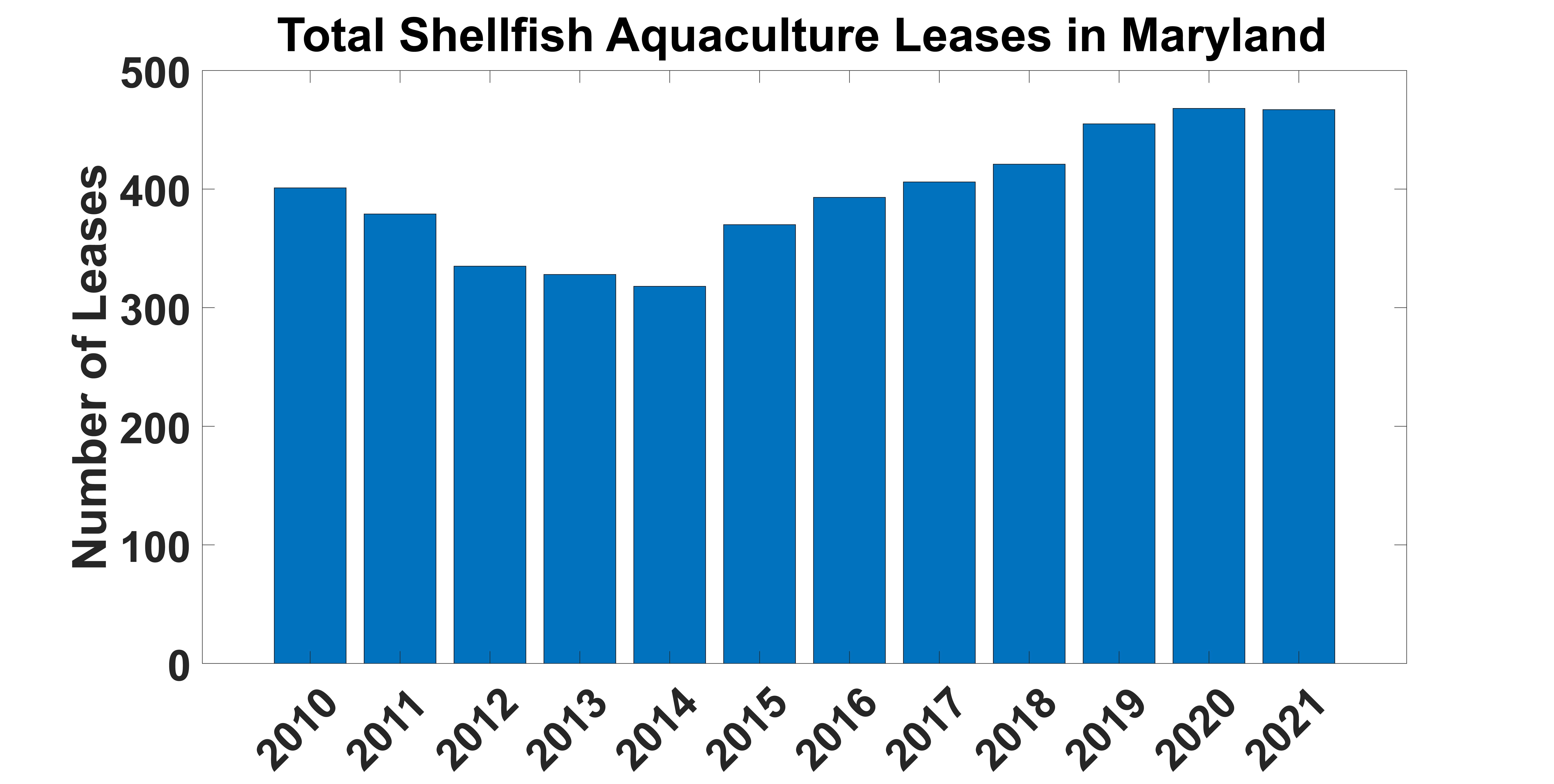
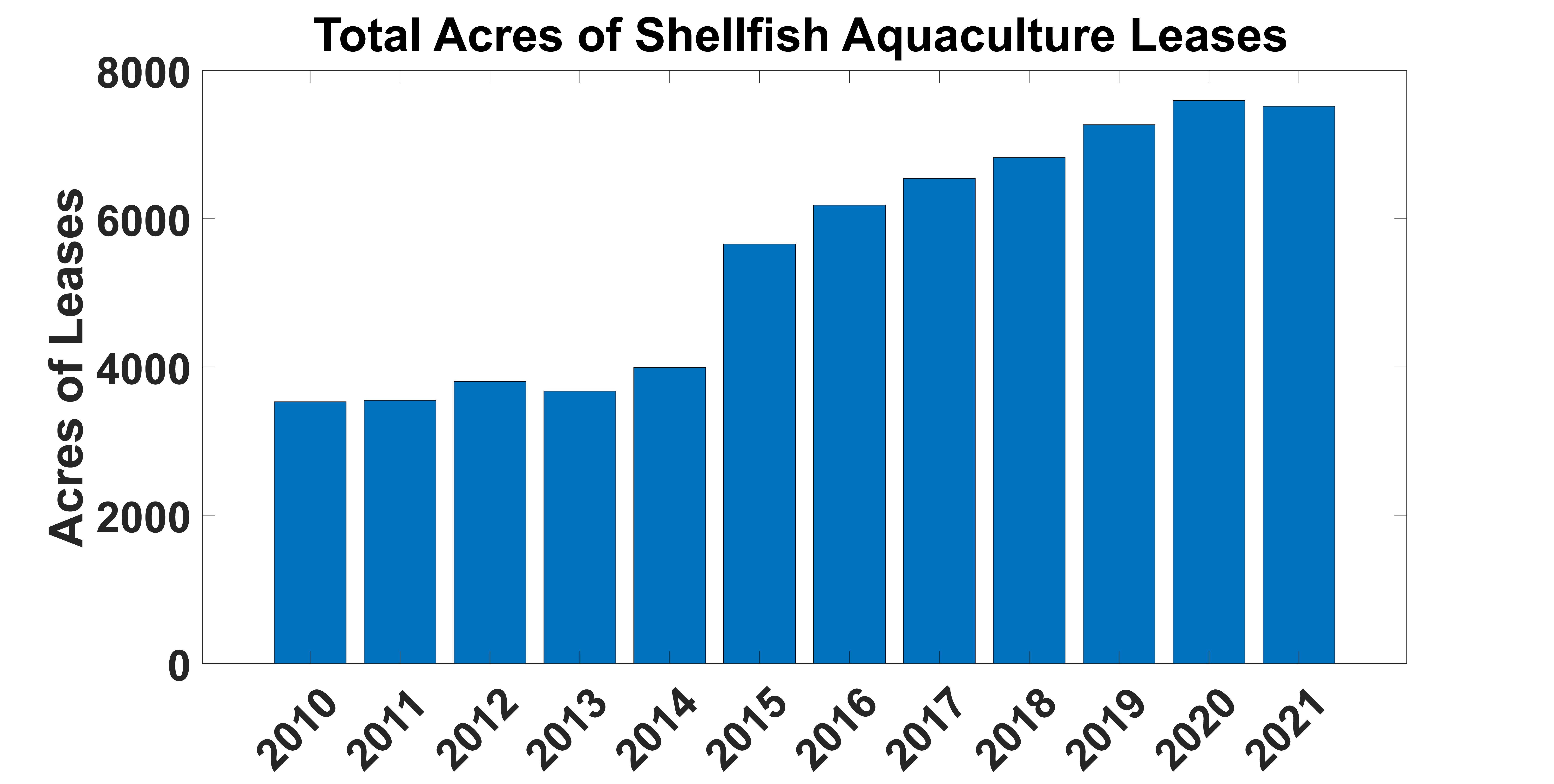
As of November 4, 2021, there were 467 shellfish leases covering 7,518 acres of Maryland waterways. Submerged-land leases accounted for 6,947 acres on 363 leases, while 104 water-column leases covered 571 acres (Figure 5 & 6) (Maryland Department of Natural Resources, 2021). These totals represent a slight decline from December 2020, when there were 468 shellfish leases on 7,593 acres (Maryland Department of Natural Resources (2020). The ongoing COVID-19 pandemic in 2021 led to slower approvals of new leases. Two new leases were issued during the 2021 calendar year, although 96 applications remained in process by Maryland Department of Natural Resources at the end of 2021 (Maryland Department of Natural Resources, 2021). There are many instances where an individual or business entity may hold more than one lease, which operates as a single business. In other cases, there may be leases in different family member names, which operate as a single business. The Maryland Department of Natural Resources collects data on each lease through mandatory reporting. It does not collect data for the total number of aquaculture businesses. Therefore, it is not possible for the authors of this document to report the total number of aquaculture businesses operating in Maryland.
Maryland shellfish leases were located in 11 counties in 2021 (Figure 7) (Maryland Department of Natural Resources, 2021). Many leaseholders hold multiple leases that range in size from under an acre to hundreds of acres. In Maryland, water-column leases are generally smaller than submerged-land types; the average water-column leases are generally smaller than submerged-land types; the average water-column lease comprises five acres and the average submerged-land lease covers 20 acres.

- Maryland Department of Natural Resources. 2020. Aquaculture Coordinating Council Shellfish Aquaculture Leasing and Permitting Program Update. December 10, 2020.
- Maryland Department of Natural Resources. 2021. Aquaculture Coordinating Council Shellfish Aquaculture Leasing and Permitting Program Update. November 4, 2021.
- Maryland Department of Natural Resources. 2022. All harvest and dockside value data provided courtesy of MDNR staff via email request from the authors.
- van Senten, J., Engle, C, Parker, M, and Webster, D. (2020) Analysis of the economic benefits of the Maryland shellfish aquaculture industry. Chesapeake Bay Foundation. Annapolis, MD. 51pp.
University of Maryland Extension and Maryland Sea Grant Extension work to support sustainable fisheries and aquaculture across the state. For more information about shellfish aquaculture in Maryland, including resources for current and new growers, please visit https://extension.umd.edu aquaculture and https://dnr.maryland.gov/fisheries/Pages/aquaculture/index.aspx.
SHANNON HOOD
University of Maryland Center for Environmental Science Horn Point Laboratory, Maryland Sea Grant College
CATHY LIU
University of Maryland Extension
FREDRIKA MOSER
Maryland Sea Grant College
MATTHEW PARKER*
University of Maryland Extension
ALLEN PATTILLO
University of Maryland
DONALD WEBSTER
University of Maryland Extension
*Corresponding author: Matthew Parker | mparke11@umces.edu | 301-868-8780 x428
The authors would like to thank the Maryland Department of Natural Resources for providing data on shellfish aquaculture in Maryland. Additionally, the authors would like to thank University of Maryland’s Extension Publications Team and peer reviewers for providing content edits and Maryland Sea Grant communications team for providing copy editing and graphic design for this publication.
Maryland Shellfish Aquaculture Industry: 2021 at a Glance (FS-2023-0672), is a part of a collection produced by the University of Maryland Extension within the College of Agriculture and Natural Resources. The information presented has met UME peer review standards, including internal and external technical review. For help accessing this or any UME publication contact: itaccessibility@umd.edu.
For more information on this and other topics, visit the University of Maryland Extension website at extension.umd.edu.
University programs, activities, and facilities are available to all without regard to race, color, sex, gender identity or expression, sexual orientation, marital status, age, national origin, political affiliation, physical or mental disability, religion, protected veteran status, genetic information, personal appearance, or any other legally protected class.
When citing this publication, please use the suggested format below:
Hood, S., Parker, M., Liu, C., Moser, F., & Webster, D. (2023, September 29). Maryland Shellfish Aquaculture Industry: 2021 at a Glance (FS-2023-0672). go.umd.edu/FS-2023-0672
Additional Resources on the Shellfish Aquaculture Industry in Maryland
-
Maryland Shellfish Aquaculture Industry: 2023 at a Glance (FS-2024-0732) >
Maryland Shellfish Aquaculture Industry: 2023 at a Glance (FS-2024-0732) > -
Maryland Shellfish Aquaculture Industry: 2022 at a Glance (FS-2023-0702) >
Maryland Shellfish Aquaculture Industry: 2022 at a Glance (FS-2023-0702) > -
Maryland Oyster Aquaculture Industry in 2020 at a Glance (EBR-62) >
Maryland Oyster Aquaculture Industry in 2020 at a Glance (EBR-62) >